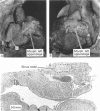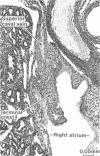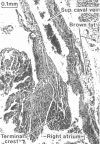Abstract
BACKGROUND--The location of the sinus node is known to be at best abnormal, or at worst unknown, in patients with isomerism of the morphologically left atrial appendage. In contrast, the sinus node is known to be an excellent histological marker of the morphologically right appendage, being duplicated in those with right isomerism. The aim of the study was to investigate this condition further in fetal human and mouse hearts. METHODS--Serial histological sections of the area anticipated to contain the sinus node were studied in hearts with isomerism of the atrial appendages taken from 14 human fetuses and 13 iv/iv mice, using 12 mouse hearts with normally arranged or mirror imaged atrial chambers for controls. RESULTS--All hearts with isomerism of the right appendages (two human and four mouse) had bilateral sinus nodes. The cases with isomerism of the left appendages (12 human and nine mouse) showed absence of a recognisable sinus node except in four cases (19%) in which a small remnant of the node was found. In three of these cases, it was related postero-inferiorly to the superior cavoatrial junction. CONCLUSIONS--The concept of isomerism of the atrial appendages is endorsed by findings on the morphology of the sinus node, this being the most reliable histological criterion for existence of a morphologically right atrium. A small proportion of hearts with left isomerism had a structure resembling the sinus node, but it was hypoplastic and displaced postero-inferiorly, distant from its expected position had the hearts possessed an incompletely formed morphologically right appendage.
Full text
PDF
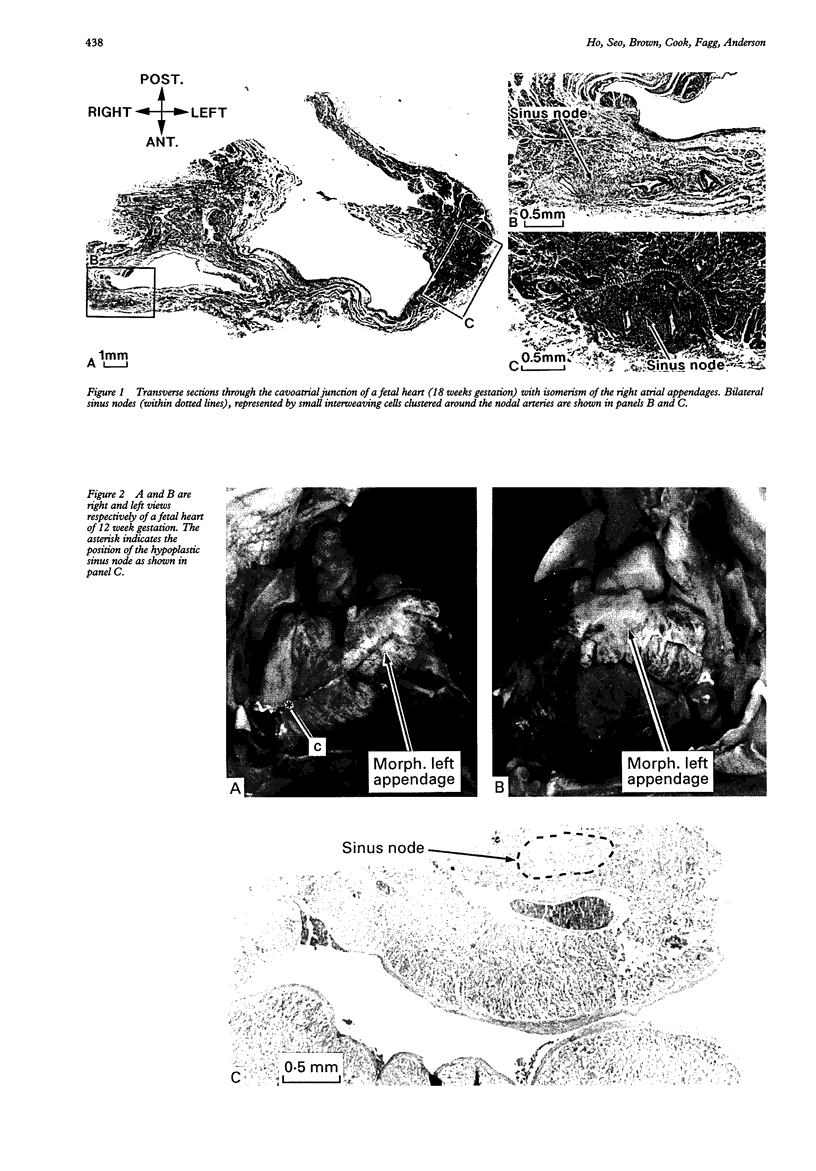
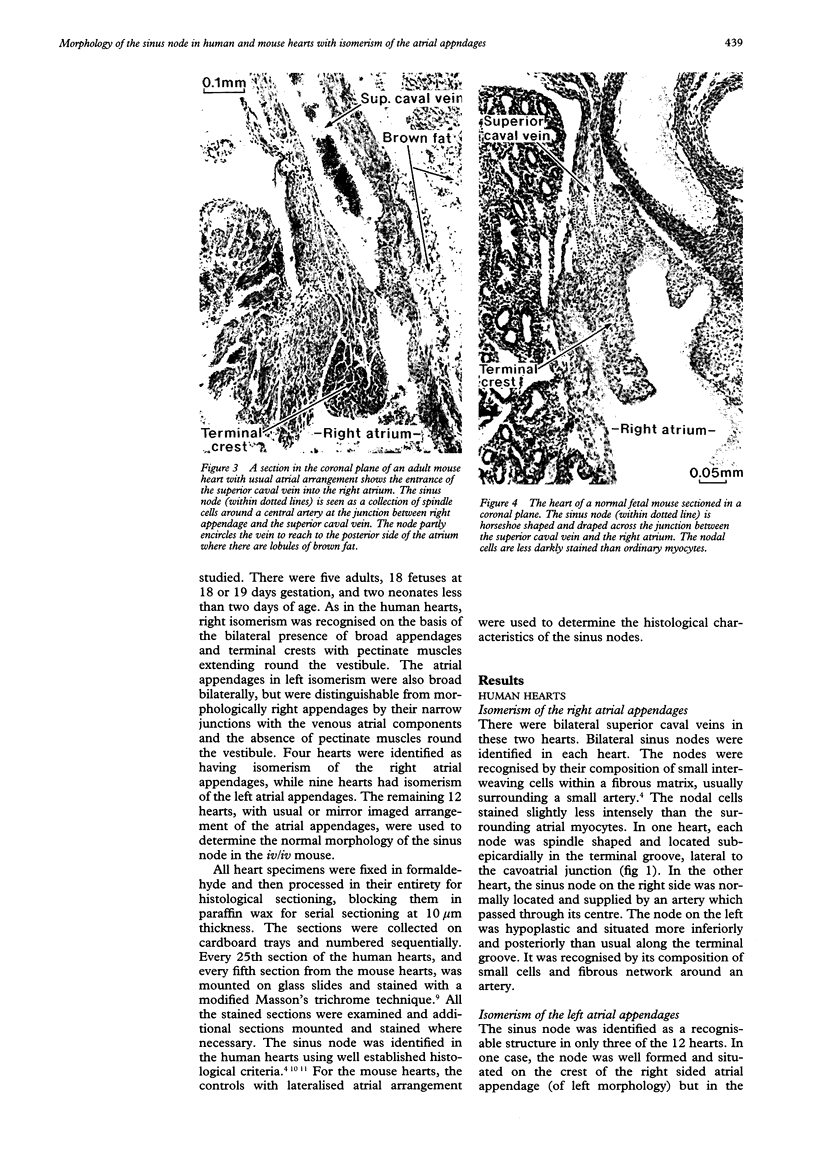
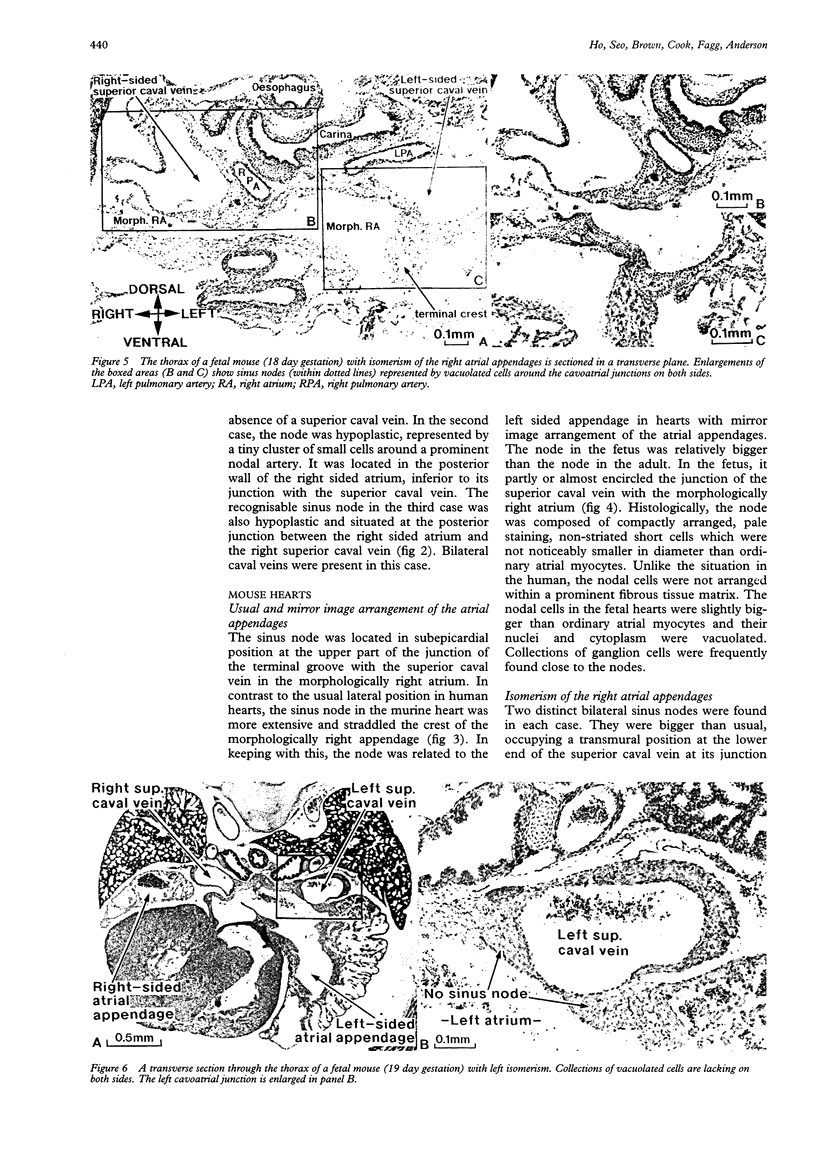
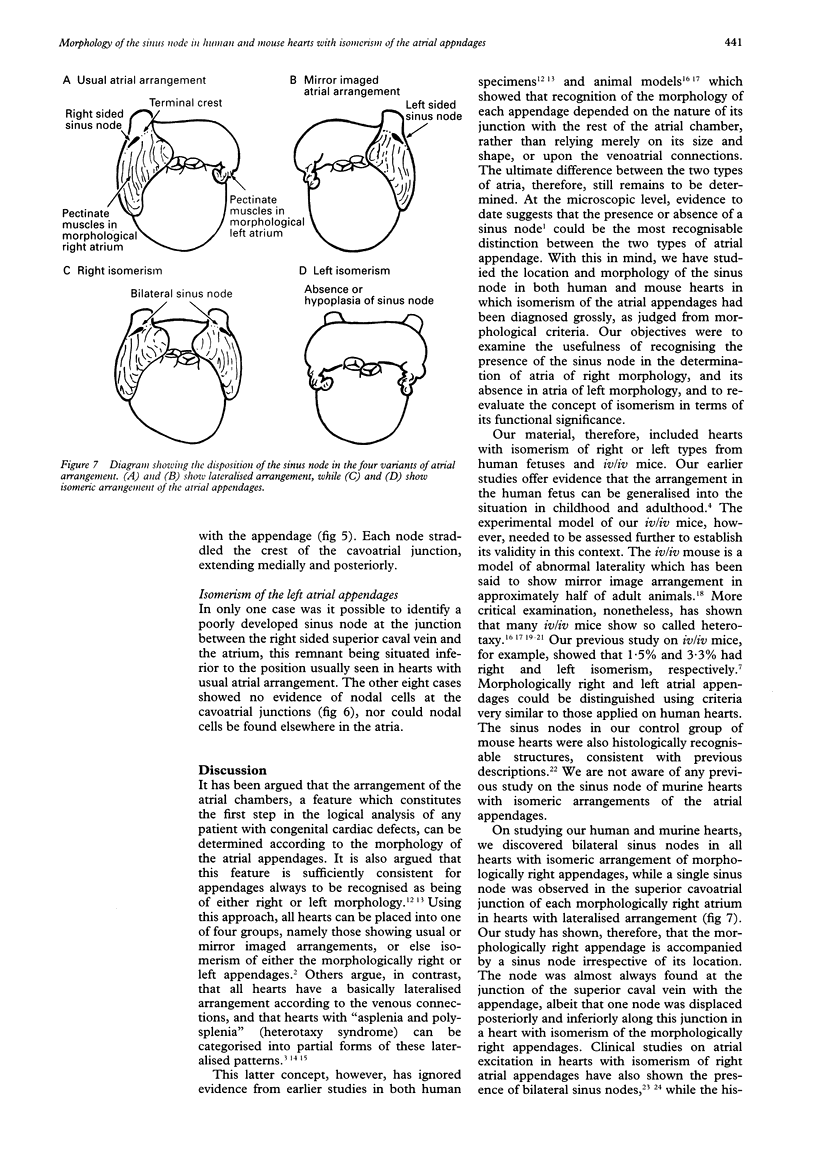
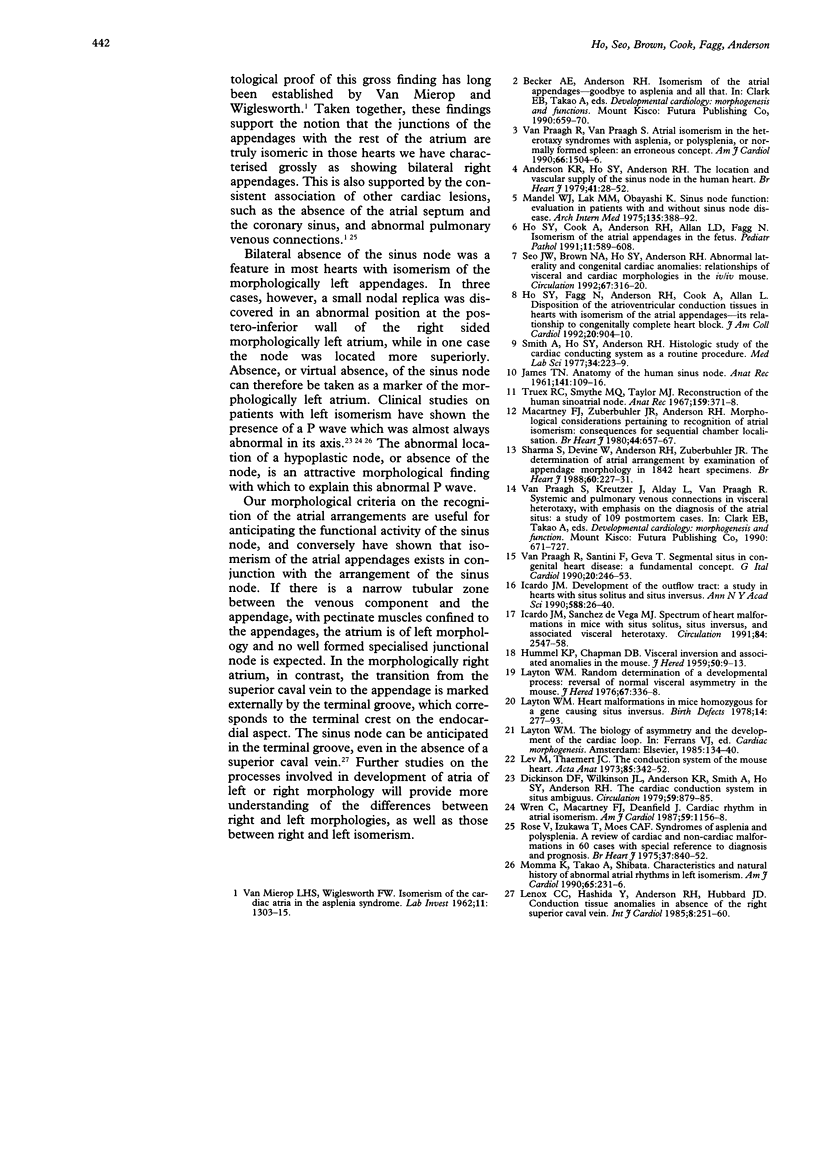
Images in this article
Selected References
These references are in PubMed. This may not be the complete list of references from this article.
- Anderson K. R., Ho S. Y., Anderson R. H. Location and vascular supply of sinus node in human heart. Br Heart J. 1979 Jan;41(1):28–32. doi: 10.1136/hrt.41.1.28. [DOI] [PMC free article] [PubMed] [Google Scholar]
- Dickinson D. F., Wilkinson J. L., Anderson K. R., Smith A., Ho S. Y., Anderson R. H. The cardiac conduction system in situs ambiguus. Circulation. 1979 May;59(5):879–885. doi: 10.1161/01.cir.59.5.879. [DOI] [PubMed] [Google Scholar]
- Ho S. Y., Cook A., Anderson R. H., Allan L. D., Fagg N. Isomerism of the atrial appendages in the fetus. Pediatr Pathol. 1991 Jul-Aug;11(4):589–608. doi: 10.3109/15513819109064792. [DOI] [PubMed] [Google Scholar]
- Ho S. Y., Fagg N., Anderson R. H., Cook A., Allan L. Disposition of the atrioventricular conduction tissues in the heart with isomerism of the atrial appendages: its relation to congenital complete heart block. J Am Coll Cardiol. 1992 Oct;20(4):904–910. doi: 10.1016/0735-1097(92)90191-o. [DOI] [PubMed] [Google Scholar]
- Icardo J. M. Development of the outflow tract. A study in hearts with situs solitus and situs inversus. Ann N Y Acad Sci. 1990;588:26–40. doi: 10.1111/j.1749-6632.1990.tb13194.x. [DOI] [PubMed] [Google Scholar]
- Icardo J. M., Sanchez de Vega M. J. Spectrum of heart malformations in mice with situs solitus, situs inversus, and associated visceral heterotaxy. Circulation. 1991 Dec;84(6):2547–2558. doi: 10.1161/01.cir.84.6.2547. [DOI] [PubMed] [Google Scholar]
- JAMES T. N. Anatomy of the human sinus node. Anat Rec. 1961 Oct;141:109–139. doi: 10.1002/ar.1091410205. [DOI] [PubMed] [Google Scholar]
- Layton W. M., Jr Heart malformations in mice homozygous for a gene causing situs inversus. Birth Defects Orig Artic Ser. 1978;14(7):277–293. [PubMed] [Google Scholar]
- Layton W. M., Jr Random determination of a developmental process: reversal of normal visceral asymmetry in the mouse. J Hered. 1976 Nov-Dec;67(6):336–338. doi: 10.1093/oxfordjournals.jhered.a108749. [DOI] [PubMed] [Google Scholar]
- Lenox C. C., Hashida Y., Anderson R. H., Hubbard J. D. Conduction tissue anomalies in absence of the right superior caval vein. Int J Cardiol. 1985 Jul;8(3):251–260. doi: 10.1016/0167-5273(85)90216-5. [DOI] [PubMed] [Google Scholar]
- Lev M., Thaemert J. C. The conduction system of the mouse heart. Acta Anat (Basel) 1973;85(3):342–352. doi: 10.1159/000144002. [DOI] [PubMed] [Google Scholar]
- Macartney F. J., Zuberbuhler J. R., Anderson R. H. Morphological considerations pertaining to recognition of atrial isomerism. Consequences for sequential chamber localisation. Br Heart J. 1980 Dec;44(6):657–667. doi: 10.1136/hrt.44.6.657. [DOI] [PMC free article] [PubMed] [Google Scholar]
- Mandel W. J., Laks M. M., Obayashi K. Sinus node function; evaluation in patients with and without sinus node disease. Arch Intern Med. 1975 Mar;135(3):388–394. doi: 10.1001/archinte.135.3.388. [DOI] [PubMed] [Google Scholar]
- Momma K., Takao A., Shibata T. Characteristics and natural history of abnormal atrial rhythms in left isomerism. Am J Cardiol. 1990 Jan 15;65(3):231–236. doi: 10.1016/0002-9149(90)90090-n. [DOI] [PubMed] [Google Scholar]
- Rose V., Izukawa T., Moës C. A. Syndromes of asplenia and polysplenia. A review of cardiac and non-cardiac malformations in 60 cases withspecial reference to diagnosis and prognosis. Br Heart J. 1975 Aug;37(8):840–852. doi: 10.1136/hrt.37.8.840. [DOI] [PMC free article] [PubMed] [Google Scholar]
- Sharma S., Devine W., Anderson R. H., Zuberbuhler J. R. The determination of atrial arrangement by examination of appendage morphology in 1842 heart specimens. Br Heart J. 1988 Sep;60(3):227–231. doi: 10.1136/hrt.60.3.227. [DOI] [PMC free article] [PubMed] [Google Scholar]
- Smith A., Ho S. Y., Anderson R. H. Histological study of the cardiac conducting system as a routine procedure. Med Lab Sci. 1977 Jul;34(3):223–229. [PubMed] [Google Scholar]
- Truex R. C., Smythe M. Q., Taylor M. J. Reconstruction of the human sinoatrial node. Anat Rec. 1967 Dec;159(4):371–378. doi: 10.1002/ar.1091590406. [DOI] [PubMed] [Google Scholar]
- VAN MIEROP L. H., WIGLESWORTH F. W. Isomerism of the cardiac atria in the asplenia syndrome. Lab Invest. 1962 Dec;11:1303–1315. [PubMed] [Google Scholar]
- Van Praagh R., Santini F., Geva T. Segmental situs in congenital heart disease: a fundamental concept. G Ital Cardiol. 1990 Mar;20(3):246–253. [PubMed] [Google Scholar]
- Van Praagh R., Van Praagh S. Atrial isomerism in the heterotaxy syndromes with asplenia, or polysplenia, or normally formed spleen: an erroneous concept. Am J Cardiol. 1990 Dec 15;66(20):1504–1506. doi: 10.1016/0002-9149(90)90543-a. [DOI] [PubMed] [Google Scholar]
- Wren C., Macartney F. J., Deanfield J. E. Cardiac rhythm in atrial isomerism. Am J Cardiol. 1987 May 1;59(12):1156–1158. doi: 10.1016/0002-9149(87)90866-6. [DOI] [PubMed] [Google Scholar]




